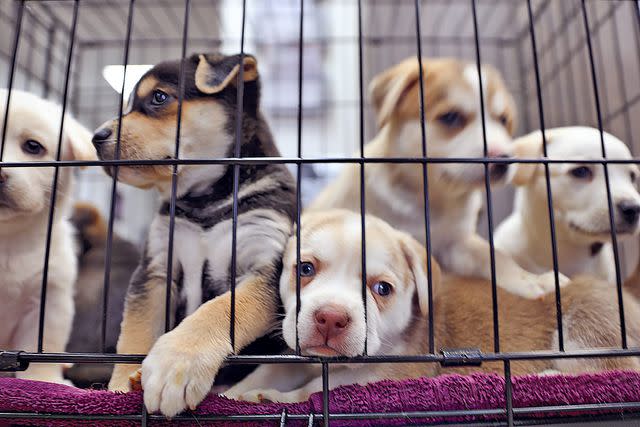We Urgently Need To Adopt More Dogs This Summer or More Will Be at Risk of Euthanasia
Adoption interest for dogs has fallen and shelters are more crowded than ever, making this summer a "fight for animals' lives."

That's a worrisome headline, but consider the situation in Colleton County, S.C., where Laura Clark is the director of animal services. Last week, her shelter housed 135 dogs—double its official capacity.
Pups were kept in normal kennels, the shelter's un-air conditioned garage area, and in cages meant for cats. Dogs who got along became roommates out of necessity.
The public shelter isn't really taking in more dogs than usual, Clark says, but adoption demand has cratered. She doesn't expect it to improve as shelters and rescues across the country enter their busy seasons.
"If this continues and there's not some kind of magical solution that happens in the next month or two, we are going to be euthanizing perfectly healthy dogs," she tells Daily Paws.
She won't be alone this summer, either. This is when many dogs arrive in shelters, a big problem when there are already more dogs coming in than available adopters. Without the public's help, shelter staff—many already overwhelmed—will be forced to make unenviable decisions as they work hard to avoid the worst-case scenarios.
"It's going to be a fight for animals' lives, really," says Michael Keiley, director of adoption centers and programs at MSPCA-Angell.
Related: U.S. Animal Shelters Are Under More Pressure Than Ever. Here Are 6 Ways You Can Help
As More Dogs Arrive, Euthanasia Increases
There aren't many fond things to remember about 2020, but headlines hailing empty animal shelters were "the feel-good pandemic story" as we learned how to live with COVID-19. Stuck in the house, millions of Americans decided to bring home a pet.
Now, the shelters are far from empty. Shelter Animals Count (SAC), a national database that tracks pet outcomes at American shelters, reported an uptick in dogs arriving in shelters. Compared to the first quarter of 2022, 7 percent more dogs arrived in American shelters in the first three months of this year.
That's on top of last year, when 4 percent more animals entered shelters than exited, according to SAC.
"We need more homes for dogs, and too many are waiting in shelters," says Stephanie Filer, SAC's executive director. "And now we're in year three and the gap of dogs arriving versus dogs leaving just gets bigger and bigger. And that's why shelters are full."
As more dogs arrive, some shelters' euthanasia rates have increased. According to SAC, the rate of "non-live outcomes" for dogs had risen from 5.6 percent in the first quarter of 2021 to 10 percent in 2023's first quarter.
That reflects a similar trend Best Friends Animal Society has tracked over the past two years. For 2021, it reported that roughly 355,000 dogs and cats had been euthanized. It was the first time that number had increased in five years. In 2022, Best Friends says about 378,000 animals were killed.
Related: The U.S. Saw More Dogs and Cats Killed in Shelters Last Year, the First Increase in 5 Years
The cause? More animals coming in—4.4 million total—and fewer adopters showing up, especially at larger, municipal agencies. Those are the shelters and rescues serving busier cities and counties, the ones who take in pets who have nowhere else to go.

When shelters like those get crowded, Filer says their staff have to juggle three main options, all of them bad.
First, non-public organizations can opt to stop taking in animals and focus on care for the ones they already have. Non-profit rescues have that option when they can't care for any new arrivals, but that's not something government-run, open-admission shelters can do.
Or they can manage the overcrowding as best they can. That gives animals a place to live, but it makes the shelter staff work even harder and puts animals at risk of not getting all the care they need.
Then there's the grim prospect of euthanization. Nobody wants to do it, but it's sometimes the only thing shelters can do to provide adequate care to all their animals. In South Carolina, Clark and her 15-person staff follow the Association of Shelter Veterinarians' Guidelines for Standards of Care in Animal Shelters, which states: "Aversion to euthanasia is not an excuse for crowding and poor welfare."
"It's not a possibility; it's a reality," Clark says. "It is the only way we can responsibly continue to proceed."
How Did We Get Here?
That's a big question without a clear answer. While intakes are up around the country, each shelter and rescue is dealing with its own circumstances. (While we're talking about dogs, shelters are concurrently dealing with the onset of kitten season.)
Speaking with Daily Paws, shelter officials and animal welfare experts attributed overcrowded shelters to:
People not getting their dogs from shelters
Economic and housing struggles
Lack of veterinary care
Tori Fugate, chief communications officer at KC Pet Project, perhaps summarized it best: Everything that affects humans also affects their pets. In Kansas City, Mo., housing is one of those causes.
It's hard enough to find an affordable place to live, but landlords sometimes impose breed or size restrictions on dogs. Then comes the pet rent or pet deposits many can't afford.
"Hundreds of dogs are coming into the shelter right now because of housing policies," Fugate says.
Her organization, Kansas City's main animal shelter, took in more than 15,000 animals last year, the most in its history—until the end of this year in all likelihood.
"Systematically, nothing will change until we are able to address some of those root causes of why pets are entering the shelter," Fugate says.
Housing aside, it's simply expensive to own a dog. Food prices have soared, and inflation has strained pet owners as well, some saying they wouldn't be able to afford a surprise vet bill.
Speaking of vet care, a nationwide vet shortage has made it even harder to schedule an appointment for our dogs. In Kansas City, Fugate says there are many areas of the city without veterinarians. Clark says she's lucky to have vets come in to perform spay and neuter surgeries, but she has to take animals with serious medical issues to a clinic an hour away.
As dogs wait in her shelter, Clark sees several factors at play. People who can't afford their dogs are surrendering them. The cost is also why prospective dog owners aren't taking those dogs home. Then, some who can afford dogs are deciding to buy them from breeders rather than adopting from the county shelter.
That leaves an overcrowded shelter, and Clark projects her "save rate" will drop to near 80 percent for the year.
"Now I tell people, use us as a last resort," she says.
What Can We Do?
This question is much easier to answer because there are plenty of ways we can all help get dogs into their forever homes. Let's start with the core four, as outlined by SAC's Filer:
Adopt a dog. Obvious, sure, but adopting a dog gives that animal a loving home and allows another dog to take their place in the shelter. Win-win. But if you can't adopt …
Foster a dog. Instead of adopting, you take a dog home temporarily, allowing them to live outside the stressful shelter environment while freeing up space in the shelter. But if you can't foster …
Volunteer. Shelter staff are burnt out and busy doing a job that can take a heavy mental toll. You can step in and make their lives a little easier—by spending time with cute dogs and cats. But if you can't volunteer …
Donate. Having to feed and care for too many shelter dogs ain't cheap, so your local agency can probably use the cash. And if they're flush, they can surely direct you to a nearby rescue in need.
Your shelter doesn't have to be overcrowded for you to make an impact. For example, adopting from your non-crowded local shelter can allow it to relocate animals from a different shelter that's overcrowded.
"If people have space in their home and in their heart to adopt a dog, this is the time they need to do it," Keiley says.
Then there's simply being a responsible pet owner. Get your dogs microchipped and keep that information updated. On the off-chance they get lost, the chip will help them get back to you quickly without forcing the shelter to spend resources caring for them.
Make sure you get your dog spayed or neutered. You and your local shelter do not need to figure out how to care for a surprise litter of puppies. Clark says if you do need to rehome a dog, do it responsibly. Ask family, friends, and neighbors before going to the shelter.
If you're able, you can still do more. Remember how municipal agencies are feeling the brunt of this crisis? Holly Sizemore, chief mission officer at Best Friends, recommends petitioning elected officials—city council members, county commissioners—to get their shelters to "no-kill" status (90 percent save rate).
"We really need local government to make sure that they're giving adequate support and helping the community get involved," she says.
Related: What It Means to Be a No-Kill Animal Shelter
Still Fighting for Animals
Best Friends measuring two straight years of increased euthanization is worrisome. (Sizemore called the 2022 numbers "startling.") But the organization measured more than 1 million euthanizations in 2016, nearly triple last year's number.
Separately, Best Friends reported that 57 percent of U.S. shelters had earned or retained "no-kill" status in 2022, an all-time high.
"[It] proves to me that it can be done, and it can be done by 2025 if the same momentum continues," says Sizemore, referring to the Best Friends' goal of the entire country reaching "no-kill" by 2025.
That goal in mind or not, ever-resilient shelters and rescue orgs are gearing up for the pivotal summer. At MSPCA-Angell in Massachusetts, Keiley's agency will reduce and eliminate adoption fees so they can keep taking in transfers from overcrowded Southern shelters, trying to generate 2,500 canine adoptions.
At SPCA Tampa Bay, COO Tara Yurkshat is seeing the lack of adoption interest, too, particularly for young, energetic bully-breed dogs. The shelter will promote those dogs to hopefully get them adopted. Later in the summer, SPCA Tampa Bay will participate in the annual Clear the Shelters campaign that offers more adoption discounts and has proved successful in the past.
"Sometimes I wonder if people delay getting a dog … because they're waiting for the time when there's no-fee adoptions," Yurkshat says.
KC Pet Project holds Waived Fee Wednesdays, when dogs 6 months or older weighing over 20 pounds go home free. But it's been operating over capacity for months, and another emergency arrived before the Memorial Day weekend.
They had dogs everywhere, and they were going to keep coming in over the weekend. So Fugate and her team put out a call to local news reporters and posted on social media. If they couldn't find homes for 150 dogs, they would face "very difficult euthanasia decisions."
It was an alarming message from an organization that recorded a sterling save rate of 96 percent last year. But it worked. Over the four-day holiday weekend, 241 animals either went to new homes, new shelters, or foster homes. Other residents signed up to foster future dogs.
"Good things are happening, but this is not at all slowing down for us," Fugate says.
Over that same holiday weekend, 168 more dogs and cats entered the shelter.

